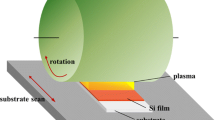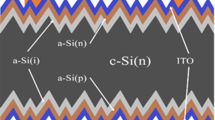Abstract
The effect of plasma excitation frequency on the performance of intrinsic hydrogenated amorphous silicon (a-Si:H) films and heterojunction solar cells by radio-frequency (RF, 13.56 MHZ) and very-high-frequency (VHF, 40 MHZ) plasma-enhanced chemical vapor deposition (PECVD) have been investigated. The thickness and microstructure of intrinsic a-Si:H films were measured by spectroscopic ellipsometry and Fourier transform infrared spectroscopy (FTIR). The a-Si:H/c-Si interface passivation quality were determined by minority carrier lifetime and transmission electron microscopy (TEM). The current–voltage (I–V) performance of the HJT solar cells were also evaluated. The results reveal that a-Si:H films developed by RF-PECVD with a large area of parallel-plate reactors (> 1 m2) exhibit better thickness uniformity, lower microstructure factor, and higher minority carrier lifetimes. Hence HJT solar cells have achieved efficiency of 24.9%, compared with cell efficiency of 24.6% with intrinsic a-Si:H films developed by VHF-PECVD.
Similar content being viewed by others
Avoid common mistakes on your manuscript.
1 Introduction
Silicon heterojunction solar cell (HJT) technology is entering large-scale industrialization because of its high conversion efficiency and high power performance [1,2,3,4,5]. The high open-circuit voltage (Voc) of the HJT solar cells is derived from the hydrogenated amorphous silicon (a-Si:H) film passivation on the dangling bond on the crystalline silicon (c-Si) surface [6, 7]. Therefore, the quality of the a-Si:H film during deposition is crucial for HJT performance.
Radio-frequency (RF, 13.56 MHZ) PECVD is a suitable strategy for the large area deposition of a-Si:H films at low temperature with good film uniformity, but its higher ion bombardment energy could lead to damage to the crystalline silicon surface [8]. This is exacerbated when the RF power is increased, resulting in a higher growth rate. Very-high-frequency (VHF, 40 MHz) PECVD is another industrial process for a-Si:H film manufacture. The electric field intensity decreases with increasing excitation frequency, which reduces the bombardment of the c-Si surface [9]. In addition, the high electron density in the plasma increases the probability of electron collision with silane gas molecules, so a high amount of SiH2 and SiH3 in the reaction can be produced, resulting in a faster growth rate of the a-Si:H film [10,11,12]. Epitaxial layers are probably formed near the a-Si:H/c-Si interface [13, 14], which are defective and decrease the interface passivation [7]. However, there are only a few reports on the performance of a-Si:H single-layer films and HJT solar cells with intrinsic layers deposited by RF (13.56 MHZ)- and VHF (40 MHZ)-PECVD.
In this paper, the film thickness uniformity and microstructure of a-Si:H films fabricated by RF-and VHF-PECVD were measured and analyzed. The a-Si:H/c-Si interface passivation quality were investigated, and finally the current–voltage (I–V) performance of HJT solar cells were evaluated.
2 Experimental
N-type Czochralski (CZ) c-Si wafers with a thickness of 150 μm were used for the manufacture of HJT solar cells. As-cut M2 (156.75 × 156.75 mm2) wafers underwent a saw-induced damage removal, texturing for pyramid morphology, chemical polishing, and standard RCA cleaning process. Intrinsic a-Si:H layers of the same thickness were deposited in conventional parallel-plate PECVD systems operating at RF (13.56 MHz) and VHF (40 MHz) excitation. Table 1 lists the main PECVD process parameters. The doped layers (p- and n-a-Si:H) were all deposited in the VHF-PECVD system under identical conditions. Transparent conductive oxide (TCO) films were sputtered by a direct current (DC) power supply at room temperature. Silver electrodes with 9-busbar were screen-printed on the ITO films. Figure 1 shows schematic drawings of HJT solar cell: (a) structure and (b) band diagram. Detailed experimental information about the HJT solar cells prepared has been published previously [15, 16].
The thickness and microstructure of a-Si:H films were measured by Syscos spectroscopic ellipsometry and Fourier transform infrared spectroscopy (FTIR). The a-Si:H/c-Si interface passivation quality were determined by a Sinton WCT-120 tester for minority carrier lifetime measurement and high-resolution transmission electron microscopy (HR-TEM) using an FEI Titan ETEM G2. The current–voltage (I–V) performance of HJT solar cells were measured using a triple-A class solar simulator.
3 Results and discussion
3.1 Intrinsic a-Si:H films
The intrinsic a-Si:H films were deposited by RF- and VHF-PECVD separately on glass substrates placed in the slot of a tray, and their thickness were tested by a Syscos spectroscopic ellipsometer. Figure 2 shows the thickness distribution of the intrinsic a-Si:H film over the tray with 7 × 8 square slots. The dimension of each slot was 15.7 × 15.7 cm, which was just for one M2 c-Si wafer. Intrinsic a-Si:H single -layer films by VHF-PECVD presented larger thickness deviations. Statistical analysis shows that the a-Si:H single-layer films fabricated by RF-PECVD have a thickness uniformity of 7.44%, while those fabricated by VHF-PECVD have a thickness deviation of 13.72%. The deposition rate, reactor size was similar for both RF- and VHF-PECVD, while the frequency was different. The large area of the parallel-plate reactor (> 1 m2) equipped with a very-high frequency (40 MHz) power supply may cause a non-uniform voltage distribution across the electrode, resulting in a non-uniform film thickness originating from the standing wave effects [17, 18]. Therefore, film thickness uniformity is a challenge when using the VHF-PECVD method.
In addition, double-sided polished c-Si wafers (100 orientation) were used for structural measurements using a Nicolet IS-10 spectrometer. Figure 3a and b represent the FTIR spectra of a-Si:H layers deposited by the RF-PECVD and VHF-PECVD methods, respectively. IR absorption measurements reveal an amorphous network structure, discriminating between the compact and porous amorphous material. Peaks from mono-hydride (SiH) bonds (2000 cm−1) and higher hydride (SiH2) bonds (2090 cm−1) were observed in the FTIR spectra. The microstructure factor R consists of the ISiH2/(ISiH2 + ISiH) ratio, which represents the quality of the films [19, 20]. As shown in Fig. 3a and b, intrinsic a-Si:H films B prepared by the VHF-PECVD system have a higher peak intensity at 2090 cm−1, and a lower peak intensity at 2000 cm−1. The calculated microstructure factor R for film B is 0.72 larger than that of film A (0.37), which means that the quality of the deposited a-Si:H film by VHF-PECVD is porous, containing voids and defect states [21, 22]. The low microstructure factor R for the intrinsic a-Si:H films A prepared by RF-PECVD could be attributed to the moderate ion bombardment that will affect the etching of the weak bonds and therefore result in improved material quality [23].
3.2 HJT solar cells
Figure 4 shows the minority carrier lifetime response as a function of time for the c-Si wafers passivation on both surfaces, with intrinsic a-Si:H films without annealing. In both cases, minority carrier lifetimes as high as 4 mms (at an excessive carrier density of 5 × 1015 cm−3) were obtained, suggesting good passivation of the c-Si substrates. More importantly, the minority carrier lifetime for wafers with intrinsic layers deposited by RF-PECVD was higher than that of cells with the intrinsic layer deposited by VHF-PECVD, confirming the effectiveness of the passivation as suggested by the FTIR results in Fig. 3.
The a-Si/c-Si interface on the HJT solar cell was observed by cross-sectional TEM to further investigate the intrinsic layer passivation, as shown in Fig. 5. A local epitaxial component with a thickness of 2 nm appeared at the a-Si:H/c-Si interface for the cell with intrinsic layers deposited by VHF-PECVD, as shown in Fig. 5b, which could be attributed to the non-uniform a-Si:H thin film deposition and the non-optimized process. In comparison, a sharp interface and no epitaxial component exist in the a-Si:H/c-Si interface, as shown in Fig. 5a. It is possible that moderate ion bombardment at the surface of the c-Si acts as a barrier to prevent the epitaxial layer from forming.
Figure 6 shows the I–V curve of two cells prepared with RF- and VHF-plasma-deposited intrinsic a-Si:H films. Compared to VHF-PECVD, the efficiency of the RF-PECVD cell was higher by 0.3%, which can be attributed to the better a-Si:H film quality, thickness uniformity, and passivation quality resulting in higher VOC, FF, and ISC. The existence of a thin epitaxial layer at the a-Si:H/c-Si interface in Fig. 5b could explain the lower VOC and FF for the HJT solar cell with VHF-PEVD-deposited intrinsic layers, due to the higher defect density at the interface [7].
4 Conclusion
The performance of a-Si:H single-layer films and HJT solar cells prepared using RF- and VHF-plasma-deposited intrinsic a-Si:H films were compared. The a-Si:H film fabricated by RF-PECVD (large area of parallel-plate reactors, > 1 m2) presented better thickness uniformity, material quality and a-Si:H/c-Si interface passivation performance, and thus higher overall efficiency. To improve VHF-PECVD-deposited a-Si:H films quality and prevent epitaxial silicon growth at the c-Si surface, further process optimization is necessary. Eliminating standing wave effect and improving film thickness uniformity put higher requirements for large area VHF-PECVD hardware design.
References
S. De Wolf, A. Descoeudres, Z.C. Holman, C. Ballif, Green 2, 7 (2012). https://doi.org/10.1515/green-2011-0018
M. Taguchi, A. Terakawa, E. Maruyama, M. Tanaka, Prog. Photovolt Res. Appl. 13, 481 (2005). https://doi.org/10.1002/pip.646
D. Adachi, J.L. Hernández, K. Yamamoto, Appl. Phys. Lett. 107, 233506 (2015). https://doi.org/10.1063/1.4937224
K. Yamamoto, K. Yoshikawa, H. Uzu, D. Adachi, Jpn. J. Appl. Phys. 57, 08RB20 (2018). https://doi.org/10.7567/JJAP.57.08RB20
X. Ru, M. Qu, J. Wang, Sol. Energy Mater. Sol. Cells 215, 110643 (2020). https://doi.org/10.1016/j.solmat.2020.110643
A. Descoeudres, L. Barraud, R. Bartlome et al., Appl. Phys. Lett. 97, 183505 (2010). https://doi.org/10.1063/1.3511737
H. Fujiwara, M. Kondo, Appl. Phys. Lett. 90, 013503 (2007). https://doi.org/10.1063/1.2426900
B Leszczynska, C Strobel, S Leszczynski, MAe al. (2018) 35th European Photovoltaic Solar Energy Conference and Exhibition, Brussels, Belgium
P. Hapke, F. Finger, J. Non-Cryst. Solids 227–230, 861 (1998)
A.I. Kosarev, A.S. Smirnov, A.S. Abramov, A.J. Vinogradov, A.Y. Ustavschikov, M.V. Shutov, J. Vac. Sci. Technol. A 15, 298 (1997). https://doi.org/10.1116/1.580484
E. Amanatides, D. Mataras, J. Appl. Phys. (2001). https://doi.org/10.1063/1.1337597
F. Finger, U. Kroll, V. Viret et al., J. Appl. Phys. 71, 5665 (1992). https://doi.org/10.1063/1.350500
K. Landheer, M. Kaiser, M.A. Verheijen et al., J. Phys. D Appl. Phys. 50, 065305 (2017). https://doi.org/10.1088/1361-6463/aa535f
R. Rizzoli, E. Centurioni, J. Plá et al., J. Non-Cryst. Solids 299–302, 1203 (2002)
C Yu, M Yang, y Zhang, et al. (2015) 2015 IEEE 42nd Photovoltaic Specialists Conference (PVSC)
J Zhang, C Yu, M Yang, et al. (2016) 2016 China Semiconductor Technology International Conference (CSTIC)
T. Zimmermann, A.J. Flikweert, T. Merdzhanova et al., Prog. Photovolt: Res. Appl. 22, 198 (2012). https://doi.org/10.1002/pip.2254
H. Schmidt, L. Sansonnens, A.A. Howling, C. Hollenstein, M. Elyaakoubi, J.P.M. Schmitt, J. Appl. Phys. 95, 4559 (2004). https://doi.org/10.1063/1.1690096
A.A. Langford, M.L. Fleet, B.P. Nelson, W.A. Lanford, N. Maley, Phys. Rev. B Condens. Matter 45, 13367 (1992). https://doi.org/10.1103/physrevb.45.13367
H. Wagner, W. Beyer, Solid State Commun. 48, 585 (1983)
A.H.M. Smets, W.M.M. Kessels, MCMvd. Sanden, Appl. Phys. Lett. 82, 1547 (2003). https://doi.org/10.1063/1.1559657
J.C. Knights, G. Lucovsky, R.J. Nemanich, J. Non-Cryst. Solids 32, 393 (1979)
J. Cárabe, J.J. Gandía, M.T. Gutiérrez, J. Appl. Phys. 73, 7618 (1993). https://doi.org/10.1063/1.352755
Acknowledgements
This study was supported by the National Key Research and Development Program of China (Grant No. 2016YFB0700703), and the National Natural Science Foundation of China (Grant No. 62034001).
Author information
Authors and Affiliations
Corresponding authors
Additional information
Publisher's Note
Springer Nature remains neutral with regard to jurisdictional claims in published maps and institutional affiliations.
Rights and permissions
About this article
Cite this article
Wang, J., Ru, X., Ruan, T. et al. Performance of heterojunction solar cells with different intrinsic a-Si:H thin layers deposited by RF- and VHF-PECVD. J Mater Sci: Mater Electron 32, 25327–25331 (2021). https://doi.org/10.1007/s10854-021-06991-3
Received:
Accepted:
Published:
Issue Date:
DOI: https://doi.org/10.1007/s10854-021-06991-3










